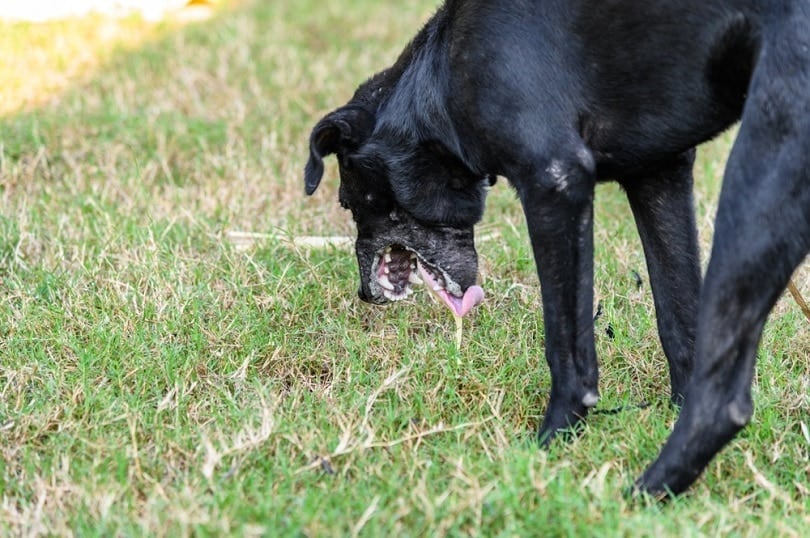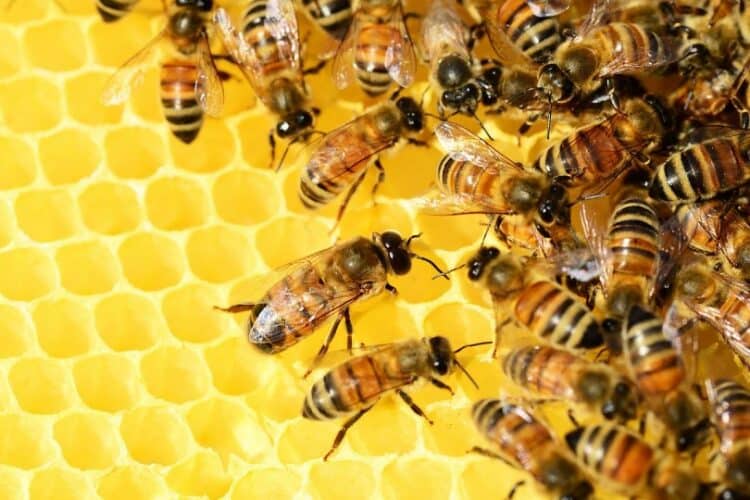They say cats suffer from their curiosity, but those people have never seen a dog’s reaction to an insect. Whether it’s a ladybug or a wasp, dogs will go after any flying creature they see. This includes bees.
As tactile creatures, a key part of the investigation of curiosity involves a taste test, right? Not ideal when the bug has a vicious stinger. So, are dogs allergic to bees, and what happens if they eat one?
As it turns out, dogs can be allergic to bees just like people. The majority of the time when a bee stings a dog, there’s no lasting damage done. The swelling and pain will go away in a few days.
However, some dogs are allergic to bee stings and can go into anaphylactic shock. If your dog is having a reaction, you should take them to the vet immediately.
Signs of a Bee Allergy in Dogs
The most common symptom of a bee allergy in dogs is itching, which can lead to excessive scratching, chewing, and licking. Dogs may also develop red, inflamed skin, hair loss, and hot spots.
In some cases, a bee allergy can also cause gastrointestinal issues, such as vomiting and diarrhea. If your dog is having any of these symptoms, it’s important to contact your veterinarian right away.
They will likely recommend doing some allergy testing to determine whether bees are the cause of your dog’s discomfort. With prompt treatment, most dogs with bee allergies can live happy and healthy lives.
The signs of a bee sting allergy in dogs are the same as they are in people:
- Swelling
- Hives
- Difficulty breathing
- Vomiting
- Drooling
- Itchiness
If your dog has been stung and is displaying any of the above symptoms, take them to the vet immediately. If they are not having a reaction, there is no need to worry. The swelling and pain will go away in a few days.

Treating Bee Stings in Dogs
First Response
If your dog is having a reaction to a bee sting, the first step is to remove the stinger. To do this, use a credit card or your fingernail to scrape the stinger out of the skin.
Do not try to pull it out with tweezers, as this can release more venom into the body. Once the stinger is removed, rinse the area with cool water and apply a cold compress to reduce swelling.
Vet Treatment
For less serious reactions, your vet may prescribe antihistamines or corticosteroids to reduce swelling and itching.
If your dog is having difficulty breathing, vomiting, or collapsing, these are signs of anaphylactic shock, and you should take them to the emergency vet immediately. Here, they may be treated with adrenaline and fluid therapy.
Home Remedies
There are a few home remedies you can try to help soothe your dog’s bee sting allergy, but it’s always best to consult with your veterinarian first.
One home remedy is to mix one tablespoon of baking soda with two tablespoons of water and apply it to the affected area. This can help to neutralize the venom and reduce swelling.
You can also try applying a paste made from equal parts of vinegar and water or a mixture of honey and oatmeal.
Help! My Dog Ate a Bee. What Should I Do?
If your dog eats a bee, the first thing you should do is try to determine if they are allergic to bee stings.
If they are not, there is no need to worry. The bee will likely pass through its system without any problems.
However, if your dog is allergic to bee stings, it could go into anaphylactic shock. If this happens, you should take them to the emergency vet immediately.
Dogs can die from bee stings, but this is rare. Most dogs who are stung will only experience minor discomfort that will go away within a few days.

Preventing Dog Bee Stings
The best way to prevent your dog from getting stung by a bee is to keep them away from areas where bees are likely to be found.
Bees are attracted to sweet smells, so avoid using perfumes or fragranced products around your dog. If you’re going to be in an area where bees are present, make sure to keep your dog on a leash and under your control at all times.
If you see a bee near your dog, move them away from the area as quickly as possible. However, if your dog has a known allergy, always travel prepared with the necessary medication.
Other Dog Insect Allergies
Dogs can be allergic to a variety of insects, not just bees. Some other insects that can cause allergies in dogs include:
- Mosquitoes
- Ticks
- Fleas
- Spiders
- Wasps
- Mites
If your dog is showing any signs of an allergic reaction after being bitten or stung by an insect, take them to the vet immediately.
There are a variety of treatments available that can help to relieve your dog’s discomfort and keep them safe from further reactions.
Final Thoughts
Dogs can be allergic to bee stings, but this is relatively rare. The vast majority of dogs who are stung will only experience minor discomfort that will go away within a few days.
If your dog is having a reaction to a bee sting, the first step is to remove the stinger and then take them to the vet immediately. There are a variety of treatments available that can help to relieve your dog’s discomfort and keep them safe from further reactions.
Featured Image Credit: Pixabay














